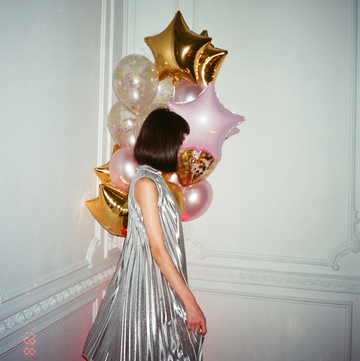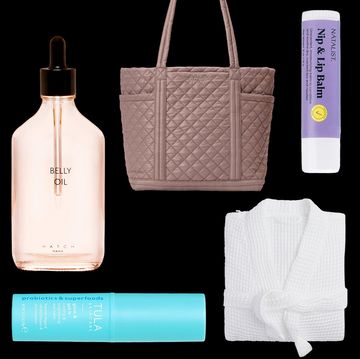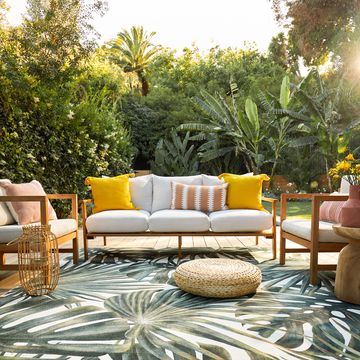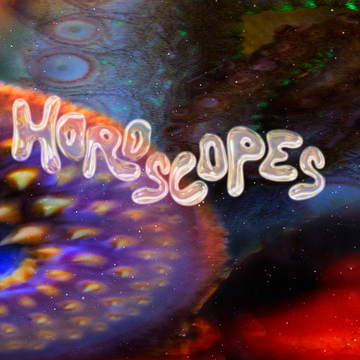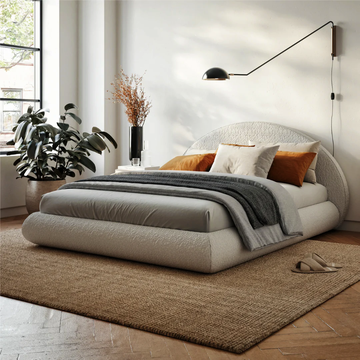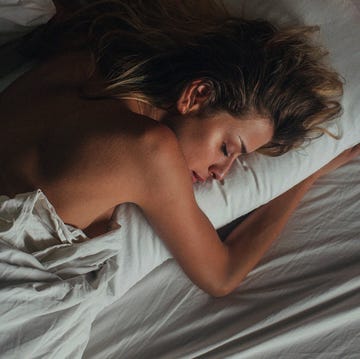Los Angeles Patients & Caregivers Group, where I buy legal weed, feels a lot more like a bakery than a grungy head shop. Inside the small back room, the bud is arranged in glass cases like rows of macarons. A flat-screen TV is mounted on the wall displaying the menu, and two pretty girls in pencil skirts wait to take your order. They sell weed cookies too, in little sealed baggies in a refrigerator on the left. Ginger snaps, peanut butter bites, and one called Vookoo's cookies. The last one once planted me on the couch for almost seven hours.
Of course, it's more secure than your average bakery. Right inside the door there's a receptionist behind bulletproof glass, who, after checking your license and medical marijuana card, will buzz you into the retail room. There are cameras in three of the four corners and a beefy guard out front. Still, after years of buying weed on street corners and in sketchy cars on the East Coast, I find it much less anxiety-provoking. If Wooderson from Dazed and Confused could see this place, he'd surely say, "Well, all right, all right, all right."
This is the future of marijuana. Or actually, no — the future of marijuana is even nicer than this.
As of this year, 23 states have legalized medical marijuana, and the majority of Americans now favor legal marijuana. Recreational pot is on the ballot in Oregon, Alaska, and Washington, D.C., this November, while Florida will decide whether to allow medical marijuana. Even the president seems to be on board with this sea change, commenting earlier this year that "marijuana is no more dangerous than alcohol." (Even John McCain, who previously labeled marijuana a gateway drug, has shifted on the issue, saying "maybe we should legalize" it at a town hall event this September.) Conceptions about what marijuana users look like are starting to change too: Just last month, Charlo Greene, a young, pretty Alaskan news anchor, became a viral sensation after coming out on air as the president of a pro-legalization group. And as pot's reputation shifts, the appearance of the dispensaries where it's sold is changing too.
"The reality is that someday soon cannabis will be normal retail next to Starbucks or a yogurt shop," says Megan Stone, a 30-year-old interior designer who has run the High Road Design Studio in Phoenix, Arizona, which specializes in dispensaries, since 2013. Dispensaries looking to attract a less grungy class of clientele turn to professionals like Stone to change their image, but just by being herself, Stone is already helping the rebranding: "Look at me. I'm not the typical marijuana smoker," she says." I'm a woman. I'm young. I'm starting something kind of trendy."
"It's just simply smart thinking to make sure your marketing and look is not actively repelling women and older patients," says Taylor West, the deputy director of the National Cannabis Industry Association. "Sure, there's a core consumer audience that starts with that traditional young white male in their 20s, but the reality is if you want to thrive in this marketplace, you have to make sure that people who are potential customers aren't scared away or offended by appearance." A report by Marijuana Business Daily projected that the marijuana industry could see $7.4 to $8.2 billion in sales in 2018. In Central Los Angeles, dispensaries have names like Sticky Medz, Euphoric, and Green Diva's Delivery Got Fire, while the newer high-end dispensaries have adopted the earthy ring of spas or vitamin stores with names like the Agrestic Green Collective, Silverpeak, and Cafe Vale Tudo.
Stone hopes to give dispensaries the look and feel of a boutique wine store. "I want to make sure these places are beautiful environments that even your grandma doesn't feel embarrassed to walk into," she says. She started working part-time as a budtender at OCPC, a Santa Ana dispensary, while she was attending design school in the area. At first, working in the marijuana industry seemed like "it could never be more than a part-time job," but a few months into her gig, her employer asked if she might pretty up the place. Stone says business increased almost immediately, and she saw a huge opportunity: No one else was specializing in dispensary design, and no standard design firms had her experience of having worked in one.
"Design isn't only beauty, it has to function well too," she says, explaining that because marijuana is a controlled substance, there are rules that vary from state to state dictating everything from how much of the product can be in a showroom to how it can be displayed.
Stone is currently working with a handful of clients, one in California and the rest in states that have legalized marijuana in the past two years: Washington, Illinois, and Arizona. "The regulations in these newer states are much greater," Stone says, "which means the people opening dispensaries there are much more educated and business-minded than dispensary owners in California. They've likely been business owners before. They know that presentation matters."
While Stone's client in Illinois can't open until 2015, he's already enlisted her to draft plans for the space and start working on the store's web presence and branding. "People come to me because they want their store to provide an awesome retail experience," Stone says. "If a patient can leave your shop remembering the good experience they had, the likelihood of them writing you a good review or recommending it to a friend increases tenfold."
Erik Briones was one of Stone's first few clients. After his two garden-supply stores closed in 2009, Briones turned to more smokable plants. In 2011, he opened Minerva Canna, a dispensary in Albuquerque, New Mexico, squeezed into an 800-foot space in an existing office structure. But earlier this year, a former fitness center four times the size of his previous dispensary went on sale next door, and Briones decided to expand. After meeting Stone at an industry conference, he hired her to help. "I definitely wanted it to be high-end," Briones recalls. "And I wanted it to be comfortable and safe-feeling for the patients."
Under Stone's guidance, Briones had the dingy front hallway widened and turned into a light-filled reception area with leather furniture and plant-patterned decals for the windows to give patients anonymity. In the retail room, which used to house elliptical machines, Stone and Briones painted the ceiling light blue to give the room the feeling of being outdoors. Briones's in-house edibles, like scones or "Cloud 9" cheesecake, are displayed in a softly lit glass case, and marijuana plants are spaced out under glass on each shelf.
The revamp cost Briones $65,000, but he says that his customers' happiness is well worth the price. "Just this morning a man in a wheelchair came up to me and said, 'I have to shake your hand for creating this place. Thank you for making me feel so welcome,'" Briones says. And happy patients aren't the only payoff. "I've had a 90 percent increase in business," he adds. Stone declined to provide estimates as to how much money she makes or expects to make in her business.
Stone is not alone in her desire to create dispensaries at which a professional crowd would feel at home. In 2011, the American Institute of Architects gave SPARC, a Bay Area dispensary nicknamed the "Apple store of pot," an award for its interior. (The storage units are reclaimed wood bins reminiscent of a library card catalog, and vintage apothecary jars showcase the pot.) Euflora, a dispensary in Colorado, pairs each sample of its strains with an iPad keyed to a description. "The people who come in are 40 to 55 years old, mostly upper-class," Jamie Perino, one of Euflora's co-owners, says. "A lot of moms. It's cool to see that." And forget about rolling your joint with regular ole Zig-Zag papers. Shine, a company formed this year, makes 24-karat gold rolling papers. (A 12-sheet pack costs $55.) Another new company, Rodawg, is set to release a line of "premium" cannabis accessories, like monogrammed carrying tins and "The Twist," a storage container in sleek black that looks like an expensive vibrator. And if anything more were needed to demonstrate the trendiness of pot, dispensaries have begun selling pumpkin spice weed. 'Tis the season, after all.
Stone even contends that a nice dispensary can make a neighborhood much nicer. She points to TruMed, a dispensary she helped design, as an example, saying it opened in August 2013 in "not so nice" area of Phoenix. "Now there's a beautiful building on the corner of an otherwise rundown area that's well lit at night and has surveillance," she says. Last winter, she says, a local Girl Scout sold cookies outside TruMed's door.
In 2012, cultural anthropologist and graphic designer Jim Heimann and researcher Ryan Mungia published a photography book called Pot Shots, showing the exteriors of dispensaries in Los Angeles. "The images are sobering," Steven Heller wrote in a piece for The Atlantic. "Forget the fantasy that once pot was legalized it would be sold in exquisitely designed, new-age, hipster head shops. The reality is that most pot stores are like any other retail façade, and most fade into their surroundings for a very good reason: The owners want to avoid bringing undue attention from the federal government, which, in fact, is currently sending letters to operators, landlords and local officials, warning of criminal charges and the seizure of assets."
This may have been the case then — and perhaps it's still the case now in some places — but the fantasy Heller describes is quickly becoming a reality. There's a yoga class in Colorado called Vape and Vinyasa, marijuana has become a "new cocktail" at weddings, and Sarah Silverman even pulled a vape out of her purse at the Emmys. It only makes sense that smokers might seek out an aesthetically pleasing spot to buy their pot.
"Customers are looking for a more sophisticated experience. They don't want to feel like they're doing a drug deal," Briones says. "This is the future. The people who want to stay in this business are going to have to step up." And if they don't? Briones doesn't hesitate: "Then they're not going to be in it."
Pictured above: OCPC dispensary in Santa Ana after Stone gave it a makeover.
Follow Lauren on Twitter.





